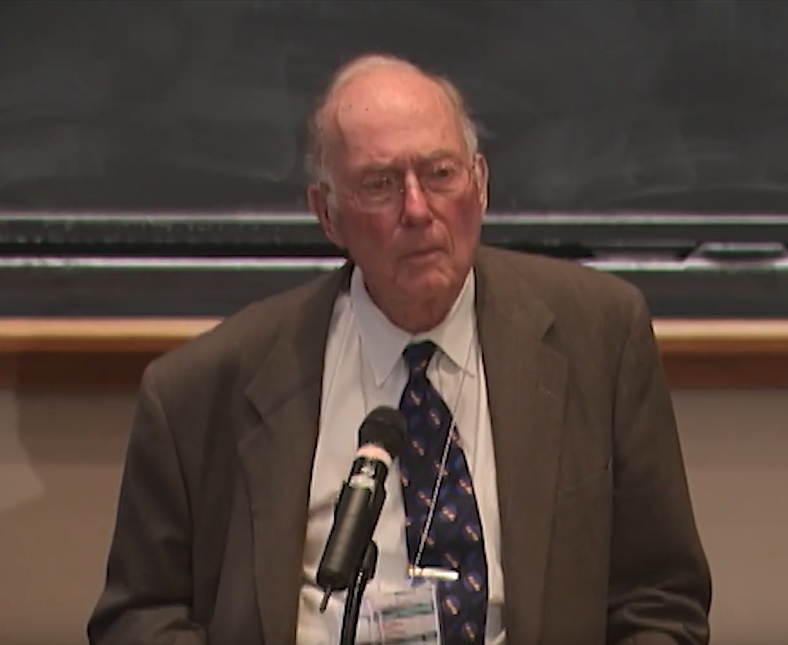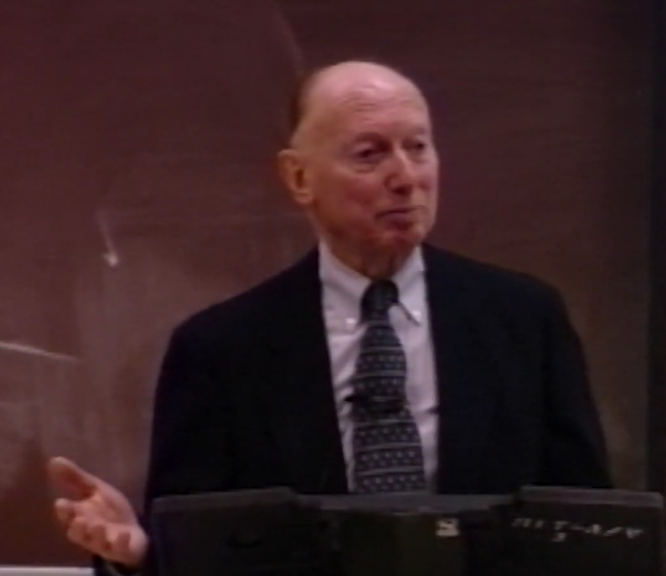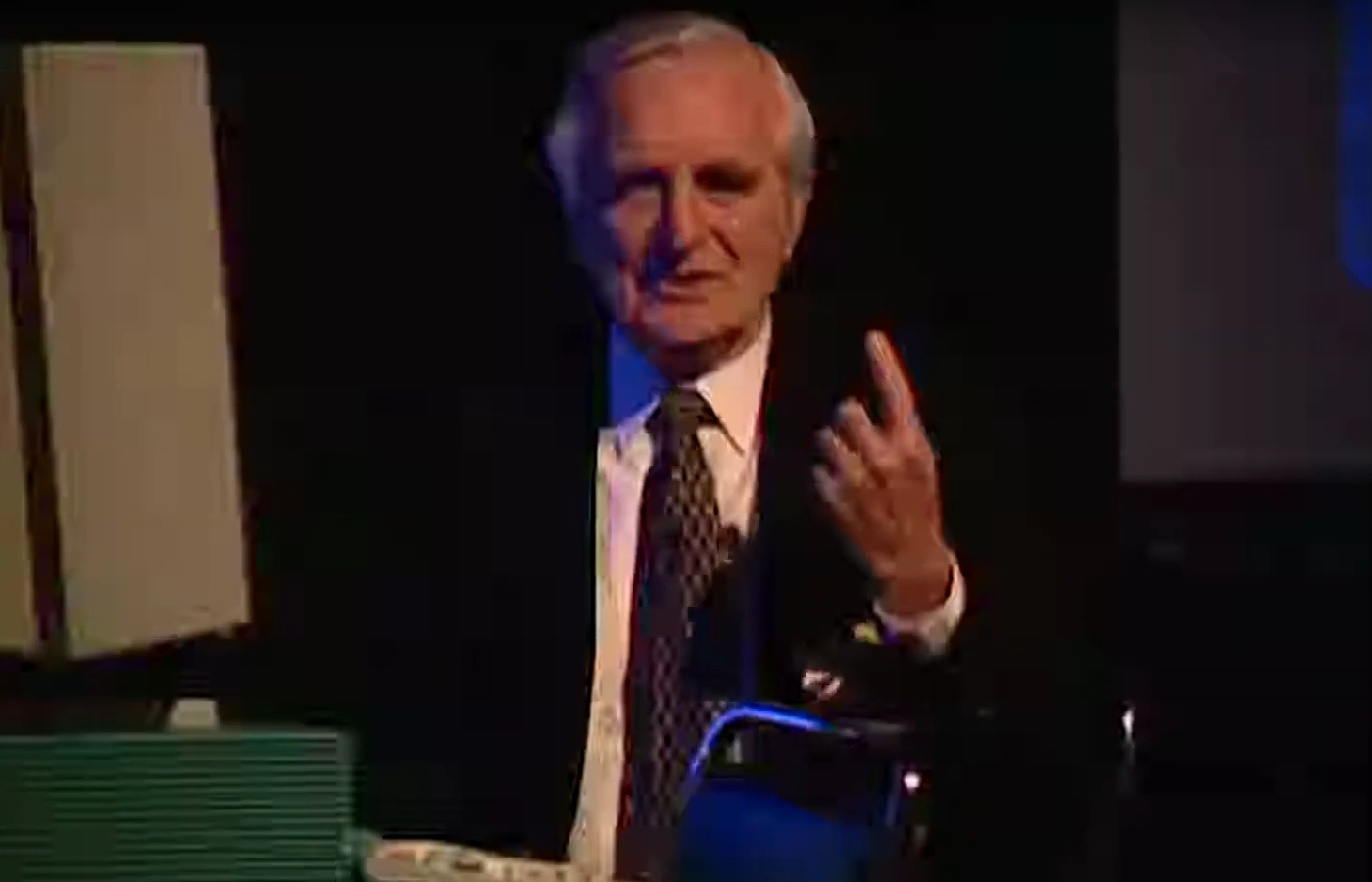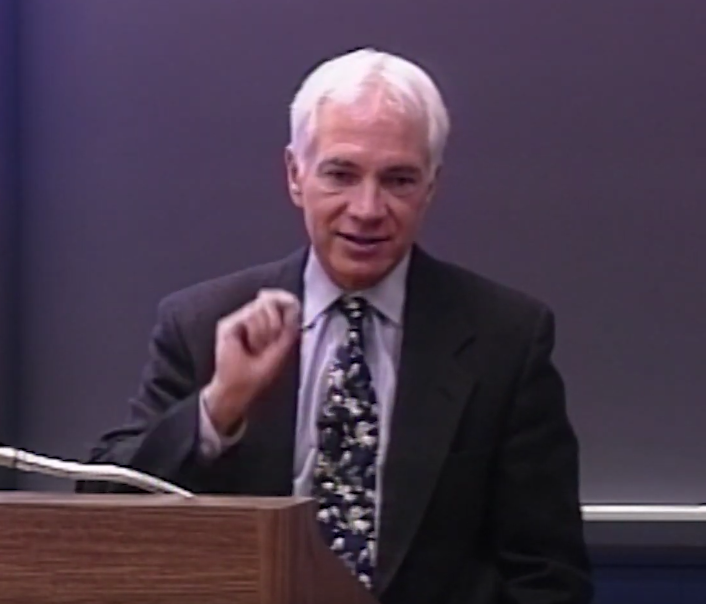13th Annual Killian Award Lecture—Philip Morrison (1985), Lect. 2
[MUSIC PLAYING]
PRESENTER: [INAUDIBLE] to welcome you here this afternoon and to introduce the second of this year's Killian Award lectures. Last week, I took a few moments to make some remarks about the award, the man for whom its named, and about the current recipient. And those of you who may have missed those will have to look on last week's videotape, because I don't intend to repeat them today.
Let me just again briefly acknowledge the presence of Dr. James Killian here, the man for whom this award is named and in whose name it is given. And with that, I look upon my function largely to fill the few seconds it takes for you to quiet down in your seat, and then to introduce the speaker today, Phil Morrison, who will turn on the fireworks. Phil.
[APPLAUDING]
MORRISON: Thank you. Dr. Killian and friends, last week I indulged in a rather complex structure of talk, which contained some account of public illusions, some account of the dreams and hopes of the physicists, and some of the problem of education, which might help to bring these things together. So it was a kind of dance of ideas and could exhaust none of them. This afternoon I'm going to give a much more focused talk. We'll still be very much a cavalier dismissal of a very large and important subject, simply on grounds of time and preparation.
I think it's an appropriate one. It just occurred to me sitting here that the time during which these notions have principally developed-- of course they rest upon a very old foundation. They are principally developed since essentially, the very year that I came as a faculty member to MIT, more than 20 years ago. And most of what I will do this afternoon is to make a very broad brush account of the progress of the astronomy of very deep space, galactic astronomy. Not on the one hand, the cosmology of the universe as a whole, about which I said something last time, nor on the other hand, the exciting discoveries about matters closer at hand, the stars and the planets.
On the contrary, it's that middle range-- it's quite a deep range-- which I shall address, because here we have come into what I think can be described in a very interesting and simple way, which makes some essential points about understanding and our lack of understanding without much regard to the great detail. I should hesitate to talk without beginning by saying that most of what I have to say is based on the results of experimenters, what in astronomy what are called observers. But really, experimenters who are provided with equipment and with understanding of what it means and how to use it by physics. It comes out of physics. It is the physics applied to astronomy.
The theoretical ideas, which these induce in us and the explanations we give are so partial and immature, as highly to be worth designating with the word theory. And you'll see throughout that it is primarily we are led by what we see. And we cobble up some kind of explanation to try to make sense of it, given the strong understanding we have of the principle nature of forces and matter that we can deal with in the laboratory. This is quite distinct from the other great frontier of particle physics, because there are so much beautiful detail is known. And there, the system is intrinsically, as we believe, simple and elegant, can be described by a few mathematical formulations. And an algebraic group or two can be found, which will say a great deal about these.
But in the domain of the large, which you're here engaging, that doesn't seem to be true at all. The variety of possibilities that lie implicit in the physics are very great. And which one has been turned on by the circumstances of their origin is more than we can imagine until we see it, because you can do almost anything, shuffling the cards dealt by Newton and Einstein, by Alfvén and Dirac, as you will. And these are what we see. So I shall have to say that here, observation and experiment far lead theory and prediction.
And the over enthusiastic notion of doing experiments to test discriminate between hypotheses is very hard to come by in astronomy and generally doesn't work. It turns out, the third leg of the fork is what you wanted. The third tine to the fork, and neither are the ones you were discriminating. And what we primarily have done is explore, but this explosion's very exciting. It's not without its rationale. And I shall try to point that out. But that's really what is involved. I am hoping to leave you with an overall view of very strange circumstances, which I think are, as they might be hoped to be, significant for everyone entirely apart from the details, as part of understanding of the world in which we are.
Now, I'm going to begin with a picture. So if we can have the first slide, I think that would be very nice. And then we'll follow it with a few slides rather quickly. In between, I might turn on some of these notes to make some sense of it. I hope you can see this slide. Maybe for this one, which is rather faint, we could kill off at least one of those lights. Can you see that slide? It's supposed to evoke. I hope you can see the reddish color at the horizon and-- excellent-- in the sky. Thank you. It's supposed to evoke a sunset. And in that sunset, which stands and will stand. And I will close the slide. Something like this will stand throughout for that kind of warming hearth by which our life is made here on earth. That is to say, the light of the star, the Sun, to which to some degree we belong.
We dwell in this hearth. We are nurtured by that sunshine, as the Earth has been, its curious fabric of living matter for pushing for billion years, and billions of years yet to come. But there is something else, of course, in that picture. It's not only a sunset. It's a sunset, which marks a line. The line is not drawn, but the line can be evoked there. These three objects and the sun, which of course, the horns and the moon point. The bow is being drawn by Diana aiming at the sun, just below the horizon here somewhere.
So you see four points make a straight line. Well, I know it's not a very straight line. But it's good enough for astronomy. And it is, of course indeed rather a nice straight line. In some ways, it's the marks a cut through what we call the plane of the ecliptic. And the greatest commonplace. By the way, it's delightful to see, and can be seen in clear weather all the time now at sunset, at least a little bit, whenever the moon is toward a new phase, because Venus has been conveniently there, and mercury, and from time to time, even Mars. So don't miss looking for this order if you haven't seen it frequently.
But now, let me go to another example in the next slide. Shows a very different straight line. I think you recognize it again. This is kind of a blurry picture of the woods around the camera. And this is a wide angle camera view, emphasizing the Milky Way with its curdled and dusty looking appearance going across the slide. Another straight line. Very interesting. And, next.
I deliberately chose these two pictures to be about the same orientation. They are looking about the same direction in space, with respect to earth and Sun. And this however of course, is a map. It is not a photograph. It is a computer generated, color coded map of the observations made by a wonderful satellite a year ago, the IRAS satellite, looking at the same direction from orbit, with its cryogenic infrared eye looking at the center of the galaxy, which is in there. And it has something like the same scale. This is a big swath of the sky.
And across that swath of sky goes this wonderful straight ribbon. And the color coding just tells you different intensities and different wavelengths. The infrared not relevant to my purpose at the moment. You can simply say that there is a layer, which is able to emit lots of infrared, dominating the sky brightness. And that layer is a flat disk. And of course, the other flat disk is the layer of the planets of the solar system. When you cut it either way, you see just a line. And of course, that's a typical situation.
Now, this is a much better view than we got with the Milky Way from Earth because you don't see very far. You're not seeing a depth. You're seeing only the nearby stuff that tends to hang in that flat disk. And of course, nearby its size bulks large. And dust is in the way. But infrared is penetrating. It goes right through the galaxy. And it gives you a view of distance center with no great problems at all. And you see again how flat the disk, or if you like, how straight the cross-section of the disk, as we look there. And I think that would be-- no, I think one more slide at this point is worthwhile making. I want to add just one more element. Really, I think I'll wait. Lights. I'll come to the next one.
Now, what I've said so far is simply that we live in what I would like to call Gush. No way is that readable. I like to call that a hearth. We live in the hearth in front of the hearth, which is the Sun. Of course, we have grown to live there. We couldn't live anywhere else really, not very well. And so it's no wonder we are superbly fitted to that environment by a long process, which is not my purpose to describe.
Now, I would like to go a little bit from these broad observations, which I think justify what I'm saying. To try to do so with physics, I must do that. The physics I will take is really drawn from the laboratory. Of course, it requires a lot of maturity. And I shall simply skip that. I'll simply assert it. And I believe most everyone will know what I'm saying and feel that it is probably right. But I could of course, demonstrate it similarly, interestingly from the lab. But I'd rather say this is what the theorists know as result of laboratory experience.
What are the forces that we look at-- whose work we look at? We look far away out into the universe, even as far as the planets. Even indeed, as far as our own lives if we drop a ball or walk upstairs. We're engaged, as we know, with interaction with the Earth as a whole. The gravitational force that was recognized and characterized by Newton. Now, why is gravitation the dominant force we're going to consider? It's negligible in the laboratory. No protons practically have ever heard of gravitation in the accelerators. They could hardly be expected to. Bulk matter, yes, it knows it very well. But individual particles, hardly at all around here.
Now, of course the answer is quite clear. And I simply want to emphasize everyone knows this, but I just bring it forward. It's the basis all I'm going to say. Gravitation is an insatiable force. It's unstable. It wants to grow at the expense of its environment. Any gravitating center-- of course, we know that gravitational force is proportional to the product of the two masses that are engaged. That's the familiar formula from elementary physics. m1 m2 over r squared, and so on. And of course, if I imagine that I satisfied the force and let some matter fall in as attracted, what happens to the force center? Why, it is reinforced. It has extra mass, and so it grows.
And in this sense, it's insatiable. The physicists say it cannot be saturated, which is just another way of saying the same thing. On the other hand, if we have electromagnetic forces, which as everyone knows are intensely stronger particle by particle-- for example, in the atom, I blanched to use the number. In the atom, they're 10 to 38th times stronger than the gravitational forces [INAUDIBLE] electron and proton. So it's no contest.
And on the other hand, they have an extraordinary property. They are not insatiable. In fact, they saturate at once, for two reasons. First, because the nature of the force. The second, because a quantized nature of charge, which comes in such limited numbers is just plus 1 and minus 1, and that's it. And none, I suppose.
And the plus minus cancel, so if I have a positive charge, which attracts unlike charges and draws in opposite draws in a negative charge down the potential slope, of course it gets a little negative. But since it was positive, getting more negative, it's not as strong as it used to be. If it gains again, it will-- and in the end, it has nothing. And so if you pile up matter, unless you're extremely powerful, when you pile up a lot of matter it will have no important electrostatic force left. They'll have big gravitational force left because the plus and minuses will cancel. But the tiny gravitation never cancels. It's always augmented. And of course, that is the reason why the universe is dominated by gravitational forces, since it consists of very large pieces of matter from our point of view. This is always spoken from r equals zero, our center, our position.
Now I will say, however, that if you have electromagnetic forces in the broad depths of space, which you are examining. You should remember also that the current, which is present whenever matter is present-- can be present whenever matter is present. And we'll see, especially true in the highly charged highly ionized domain of space.
If currents move, they tend to short out electrical fields. That's just the argument I made. They move towards down the field and cancel when they get there. On the other hand, those very same currents nourish the B field, the magnetic field, because it is current that makes B field, and not charge. So even if I have equal and opposite charges moving in equal and opposite directions, cancels out charge wonderfully, but only augments the B field splendidly. So the B field indeed is the only product of magnetism we will see. We have, perhaps the most interesting arguments of not the last 20 years, but the 20 years before that, in all of deep space astronomy, where the demonstration there were indeed extensive magnetic fields in space. And I shall drop on that later. So that's what the forces are.
And now, if you want forces on charges, if there's no electric field, then the forces of gravitational, which are small. Or if you have individual particles and a B field is moving by, you can take advantage, broadly speaking, of what is called the Lorenz force, the velocity dependent force, V cross B, which works on a charge. And the physicists will know right away that that's what goes on behind the motion of individual charges, should we ever see such things in the course of our studies.
Now, it is appropriate, having discussed the forces, also to mention the forms. And here, I think I'd already given the forms. And I will just uncover the discussion that I want. Of the forms, that means geometrical forms under which these forces exist in space. It's a very old and long established proposition. The first form, of course, is the sphere. And the sphere because it has no orientation, is a sign that random motion is there, struggling against isotopic, every direction the same gravitation.
Gravitation is a central force. It draws toward the center. The sun draws its planets. The earth draws everything on its surface. And the bodies are beautifully spherical. And the moon in the first picture was spherical, only half illuminated by the sun, quarter illuminated as you saw. And you know very well, this is the phenomenon that all the objects that are sufficiently large and thus dominated by gravitational forces are in fact spherical-- all the nearby objects.
Now there is, of course, something to be said against that. It's very nice to have this. By the way, the random motion in the case of the sun, we know it's the gas pressure of the hot gases within the sun. Very reasonable. And we'll see other examples. The what I now call and intend to call the disk, that is the flat plane in which the planets move, and which the galaxies material seems to be gathered preferentially together. That disk is a two dimensional motion. The planets orbit. They do not whiz up and down. The axial velocity has disappeared. And this must be a historical thing.
And now you see we've come into the problem of history, which will dominate this entire first discussion, because why should they not have motions in all directions? Well, we begin to see now. We can see that if you have a system, such that it can lose axial motion, it will not fall in by that virtue because it is only the motion in the plane at right angles to the axis, going through the revolution and axis that keeps the thing in place. So if you don't lose that, you'll still stay in place. Yet, you will change from the three dimensional randomness to a two dimensional flat plane, a phenomena which seems quite important, since it dominates many skills.
Already we've seen it dominates the solar system's planets, the orbits. And it dominates the orbits of the stars and dust that make up the vast plain of the Milky Way. They're very striking, but that should be seen. And these two forms, sphere and disk then acquire their realism from this argument. And to go a little further into mechanics, I will say, all right, here is meant to be a random sphere. And I can characterize that random sphere in a very nice way by using what all students and mechanics will recognize as the Virial theorem. I just don't worry about the name. A fine old Latin name.
The kinetic energy is about equal to the potential energy for any system held together by gravitation that is in a steady state. And that's what we find. So if you have a lot of particles moving about, they better have as much kinetic energy as their gravitational attraction. And if they do, they'll be able to withstand. Otherwise, they'll collapse or blow up, do one way or the other. So steady state is going to require that. And this, of course, is-- in a way, you can say this is why the sun is hot. Or if you like, you can say that because the sun is hot, it must be bound by a certain amount of gravitational force. Gravitational force is very large. That makes the sun very hot. Or either way, the two are related. And this is the way that the gravity is fought by random undirected motions.
You see, gravity being insatiable must be fact, or otherwise the world could collapse to a single point somewhere. And what has beaten that back is in every case, some kind of motion. Perhaps not so on the very, very lowest level of size, where perhaps the actual repulsive forces might exist. But barring that small exception, it is really motion-- motion in the sun, which is gas pressure, motion in the galaxy, which is the sub orbiting stars, and motion in the solar system, the orbiting planets. And in every case, it is motion that inhibits gravity.
There is no such thing as a shape, which is not connected with motion. Aha, you say. The Earth itself is a sphere and I've suppressed that. But, of course, everyone recognizes the Earth is kept up by the forces in solid matter. And those forces, indeed, are also primarily random pressure, not however, due to the thermal motions so much, as to the repulsive effect of the overlapping electron crowds and atoms that prevent matter from collapsing onto itself. I shan't discuss that very much. But that's often called a Fermi or shredding of pressure, which does the same job. In any case, that's what it is.
I mentioned one other important point. We know in mechanics, the energy as a constant of the motion, we know the angular momentum as a constant motion of vector constant rather more complicated and it's playing that it is keeping J, that requires these particles to stay in this plane. They don't fall in because they would have to lose any momentum to do so, it's very hard for them to do that. It's much easier to lose energy than to lose any momentum. Indeed it turns out that these properties I'm describing are properties of a gas and many interacting particles and perhaps that also is the origin of this form both in the galaxy and in the solar system.
I don't press them too strongly. Now the next thing I would like to describe, because I must have a background for pictures I'm going to show you, are the substances of which the world is made. Now above all the world is made of hydrogen gas, wherever we look that's what we see, it was first brought forward in a brilliant PhD thesis in 1925, by Cecilia Payne, then a graduate student at Harvard College Observatory and this perhaps most brilliant of all, astronomy PhD theses. She concluded that the world indeed, with the sun and the stars in mind, were made of about 90% hydrogen and cautiously she and her advisor added well perhaps there's something wrong with the story that seems so incredible, but that's what the calculations suggest.
By now it's been enormously confirmed and we know that all that we see in fact is made of hydrogen. Hydrogen has many different forms, I mentioned them, there's even another one I didn't mentioned, as being too complicated but hydrogen metal, let's let it go. We have H2 molecular hydrogen, very significant in the galaxy. H neutral atoms of hydrogen also quite significant in the galaxy. And separated hydrogen atoms, e minus p plus, drifting about which we might call hydrogen plasma or ionized hydrogen, also quite significant.
Now, I want to point out, of course, that gas is lassy, gas loses energy, doesn't keep it and radiates, in general. Turns it into photons and emits the photons. This is how we can do astronomy anyhow but of course this loss of this is very characteristic of gas, that's not true of the Earth's orbital motion, for example it's been going around for a long, long time. And while in principle it can radiate away its emotional energy, not by charge, which has nothing of but by mass which it has by gravitational radiation. To do so, takes something like 10 to the 25 years, a time so long that we can leave it out of all considerations of our present time.
Because gravitational force is so weak that the radiation they enforce for moving matter is so small that it's entirely negligible as long as you deal with simple circumstances, like the one I'm talking about. Now the second proposal is the rock of the earth, of course, and of the terrestrial planets and here I've written down as an astronomical sign, rock broken into small bits which is what we call dust and dust which is rock dust. I shan't describe whether it's silica, what it is. It's some element, not hydrogen, and it has many possibilities.
Now I think a slightly worthwhile, the one that I cut off, just look at that quickly, this wonderful star field in the southern hemisphere, a beautiful photograph from the Australians, is blurred by this object here and in the old days it was possible still to believe absent much mature consideration and lots of statistics, that you were looking here as Herschel himself wrote about a similar object, at a hole in heaven. [INAUDIBLE] The stars get out of the way and show you a beautiful tunnel out into depths of space.
Of course, that's not at all true, if you think about the statistics of it you will see it's very unlikely, so many dark fingers are pointing at us, he saw just one maybe, but if you see hundreds of them, then you have to have very bad ideas of reference to think that heaven is making all these dark fingers pointing at us or else a very bad conscience. I don't know.
Any case, we know that's not by looking at the light coming through and by looking at many other ways. We this is just a dust bank which gets in the way and behind it, that wonderful field of stars is blanked out, and all you see is the stars that are in front of the dust bank and that's only rather few because it's rather close to us. So dusty is an important and obvious consideration, now you would say obvious. But in 1930s, it was not so clear but now we have unmistakable evidence for it in many different ways, and we know that it's really there.
So we have hydrogen and then a little bit of dust. I wanted to mention it because you'll see it over and over again is just the same completeness. And the third thing, which is very interesting, is a construct which you won't find in the laboratory at all because I call it star fluid. So the third element that I want to talk about is star fluid. Now what is star fluid? Star fluid is obviously kind of a metaphorical name for something you see from a big distance and don't see very well, because star fluid is a fluid whose atoms and particles are stellar and not atomic.
That's the way it looks you see a picture of a galaxy. Let's look at a picture of the galaxy. There you see a beautiful sphere of star fluid, now we know by sampling there are a billion such objects, we know tens of thousands of them with some degree of detail by actually having studied them individually. And they represent something like the Milky Way. Here's a couple little outliers, that's a nice big spherical, one the same one I showed last time.
And the next slide, a more familiar one, a spiral galaxy instead of a globular galaxy. I chose this one to show both kinds are present. And again you see right away the same theme, a sphere and a disk. In this case the disk, which happens to have a small sphere inside it, that's all right. Combination, not too bad. And again, the same situation, we must have random forces opposing gravitational pull on the symmetrical situation. We must have somehow, a system that has lost an [INAUDIBLE], that has tried to keep it's [INAUDIBLE] and lost energy and has made a disk and the two symmetries the disk and the sphere correspond to everything galaxies are either spheres or disks or both.
Just as the solar system is a sphere, a star, many little spheres running around and they're organized in a disk. It all looks so simple that it gets almost a little familiar. I want to show something else to show, it's not quite as quick. That was a bit fast. Can you come back to the previous picture? I'd like to talk about it for a moment.
There it is again, now this looks very bland but one reason it's bland is because the instruments in which everything depends, there's no way to get knowledge except to the instruments. Every instrument makes illusions and the expert who handles it knows the illusions but when you look at it hastily you might miss it. Many theorist miss it for a long time. There's been a long time getting this lovely outside tracery just right.
By long exposures to bring out this faint stuff, way on the outside, with all that interesting intricate material. But when you do that, you burn out the middle. It's flat bland. Now a little spot, not as big as the red light that I put there, the laser spot right in the very middle is shown in the next slide. A very short exposure, and there it is. That's the bright nucleus, the Andromeda Galaxy.
Now, there's nothing particular about it, we I take a long exposure, we get a bigger thing and longer. What I want to point out is the stars are heaped up toward the center of the galaxy with a remarkable rate of rise, so the density of stars and of star light from the center is three or four orders of magnitude greater than the stars pile together in the same small volume outside. The volume which this occurs is very small, so the total computational light of the object is not large, but compared per unit volume it is 10,000 times more dense.
The absence of dynamic range, the ability to get [INAUDIBLE] and crescendo in the same passage, that most instruments lack that. I'll show you some later that don't lack it and you'll see wonderful things that lots of dynamic range brings you, because you can't always neglect faint things. Small things may be quite significant. In this case, the small, the high intensity of that is quite significant for us. The next slide is just to show you these things are not always separate. Here I have a picture of the coma cluster, the certain point in space, rather far away from us a couple of million light years.
You see there is a sort of an ellipsoidal galaxy and a few more. And then there's [INAUDIBLE] spiral and there a nice spherical looking one and some funny ones. Bunches of galaxies in the single picture. You can count a couple of hundred in that cluster with no trouble at all. So these things do occur, they cluster, the galaxies are present. This is all the classical material of the astronomy texts some time ago. I would like to add that you see this the stuff that I'm talking about, I should give a name to that. I observe it as a homogeneous material in these pictures, that is the only way to see it but it's star stuff, it's fluids.
It's a fluid made of stars, its form is what is most conspicuous in this kind of picture. I came with a spectrograph, examined the light in detail, and I can map it and see how the density changes and so on as I've shown you. So we do have a little more information. But primarily we're studying star fluid. It's perfectly good to call it that because that was made of individual stars, and those stars are not touching each other. We see them as though they fill all space. That's because the instrument is not capable of separating them. Instrument, including the atmosphere, is not capable separating them.
They run together and you get a glow, the glow is actually the sun-light of 10 or 100 billion stars. No one of which is close to the other and no one of which practically hides the other either, they're so far apart by comparison their own size. Like the stars in our neighborhood. But you see the merge together in the instrument just makes a star fluid of it. So it is a star fluid and it's worthwhile mentioning it. It's quite important.
So I will say the star fluid is there, fluid moves about. It is what heaps up into a sphere in the spherical galaxy and is flattened out into a disk in the disk galaxy, and maybe a sphere in the middle. It is lossless-- the stars haven't got any way of getting rid of their motional energy. Of course, individual stars can get cooler or warmer-- whatever they're doing on their own individually, and I observe that that belongs to stellar [INAUDIBLE], not really described.
Very interesting and almost mature between 1920 and 1970. Roughly speaking, that was the time which we understood most-- not everything-- most of what stars do. So this lossless fluid, it's lossless in its motions. It has no way-- it doesn't collide, it doesn't bump into-- do those stars bump into each other? They don't.
The friction they have from the residual gas which might be present is very small. How can you stop a star with just the friction of gas? You can't do it. And so it is a kind of perpetual flow of fluid-- a very nice thing to study [INAUDIBLE].
Of course, don't forget two things. First, it's interactive. Though it is lossless, it is by no means inert because it is attracted-- attracts gravitationally with great vigor. We're talking about little parcels of fluid floating about-- each one has 10 million stars in it. It's not a small concept-- there's lots of energy there, lots of gravitational attraction. But of course, it can evaporate, it can dissipate.
And if it's thrown out into space and made very dilute, we don't see it because we can't see just a tiny bit of light against the background of everything else. So you have to have it less than dilute in order to see it. So that's the third material.
But now in terms of that material and the two things I've described, namely the hydrogen dust and star fluid, we have a description of all that we can see in galaxies and the solar system. Solar system is the prototype. And then in the galaxies world, which I'm talking about, the galaxy does the same thing. Disks, and spheres, and their combinations, clearly a balance of energy and angular momentum-- the great constants of mechanics.
The star fluid flowing about and adjusting itself to fight the gravitation either with spherical random motions or with well oriented, circular motions, or quasi-circular motions. And of course, there are lots of small differences, there the famous density waves that make the spirals of professor Lin and so on. But these are, from this broad brush portrait, details.
Very interesting and significant for origins perhaps, but not determining the broad picture. I haven't had to show you pictures of those which was very conspicuous. So I can say that the solar system and the galaxies ruled by gravitation, as we admit, made of hydrogen. Of course, the hydrogen makes up the stars too, but we're not talking about the stars except as parts of the fluid. And a little dust thrown around to make the earth and the dust of space.
Solar system and the galaxies ruled by gravitation seem as tranquil as the almanac. The rounds of the heavens, while quite interesting, and the gyrations are fun for us to watch and study, and we can time ourselves, and navigate and do wonderful things, it is really the almanac. You look it up and there is just what it will be. It's already out for 1989 I believe, and it's going to be right. You won't find any errors.
[LAUGHING]
And that's about all you can-- that's the only part of the subject which has that quality, I can assure you. And of course, that quality enormously misled us until we got better instrumentation and better understanding. This is home. Home is where the hearth or heart is, and home is where you get your wrong ideas.
[LAUGHING]
Okay, so now we'll talk about what 20 years has brought, mostly because you have the ability to look rather far away. Because if-- you may well believe home is where the hearth is-- it's not a coincidence, yes? Here I must invoke the fact that if it were not that way, it's very hard to make a living. You can only work when the sun rises every day, or at least on weekdays and things like that. So you've got to have a general regularity.
Are the irregularities, disorder, chaos, lack of equilibrium, lack of clear temperatures, disks and spheres-- are those things the solar system? You bet they are. Cosmic rays, aurora borealis, comets, meteorites, asteroids, but you've got to be an expert to know about them. Well, perhaps you can see a comet from time to time.
And the ancients were right to feel the comet was a sign that things are going wrong, because the comet-- I have only to point out one remark-- comets, of course, are not very bright, but comets are not in the ecliptic plane. In fact, they're uniformly distributed in direction. So how come?
We have a good argument. Well, it shows the details, if pursued, will lead you're far away. And so we didn't-- we weren't wholly deceived. But broadly speaking, we had the illusion that gravitation is a delicate subject which works on fine details. And you can get-- yes, the procession of mercury was a little ahead, and so Einstein could make a great thing of that. That's the kind of style it was, and so that's the way we did the thing for a long time. But that was once, and it's not any longer.
Now, I say, we come to the fireworks. It turns out that this entire picture is based on experience, common sense-- the common sense of the scientists engaged in galactic and planetary observations-- but it's wrong. I should not say it's wrong-- it's not a blunder. It's incomplete.
And that's of course generally what we have. We have well-founded theories, well-founded descriptions that don't cover all circumstances. They cover our circumstances at the time, and that's why they fit. And when you press the limits, you find something new happening.
So I come to-- and it'll turn out that I get to introduce, we got only one more new substance. It isn't substance that's novel, it's motion and form, and we'll come to that as it goes on. In the first place, I think we should look at a slide or two.
If galaxies cluster, they come close together. When galaxies come close together, they sometimes approach each other and confront each other in this interesting way. This is a square dancing pair of galaxies. And it bear's tails-- I mean, gosh.
[LAUGHING]
That doesn't look like anything you ever saw in the typical book of some years ago. It was there all the time, but it was only 100 out of 10,000, so who's going to bother pick up such an anomaly? And now we understand a little better. And the second picture-- this one is called the antennae for obvious reasons. And here, the galaxies are flinging something over each other's shoulder in a strange way.
This has been beautifully modeled by [INAUDIBLE] here for the past 15 years or so in simulated effect. And there's no question of what we're seeing, and I would describe it in the following language. You know by direct observation that the motion in those twigs, those branches that come out, is not an anomalous or strange motion. It is a motion rather like the rest, but the form is very strange.
What has happened is that the tidal flow has drawn out star fluid, which also can recoil gravitationally just as the tidal bulge recoils from the moon-- if you know there are two bulges of the tides on the earth. And drags with the gas, and if galaxies will collide with each other-- that has come near each other-- then this beautifully stabilized sphere disk fluid that we talked about, which has no losses and responds beautifully to any pull upon it, gives up its allegiance to that beautiful order, which was all historical.
No longer has zero angular momentum. It has zero angular perhaps, or it has the right kind of angular momentum with respect to its own center, but now a conflicting center has entered. What to do? It has now a lot of angular momentum in respect to that one.
It makes some kind of a balance, and a complicated thing ensues which I shan't describe, but has been worked out in beautiful detail by computer simulation and, to some extent, by analysis. And in these collisions, we are quite clear that the star fluid is drawn out. Its just stars with accompanying gas-- nothing bizarre-- but drawn out into tails, and even rings and mergers. And the next slides will show you what some of these things might look like.
This is in the sky-- this is not something in the computer. It's a bad photograph of a rather remote galaxy, but it's a funny one. It's a blobby ring. I mean, looks like some-- I suppose some piece of pressed pasta you might get like that-- like alphabet soup.
Well, look at the next slide which is a computer simulation of [INAUDIBLE] and coworkers. [INAUDIBLE] this one. Suppose you have a model galaxy-- just stars moving around in nice, circular rings around an axis, and I fling through that axis right down there. And another galaxy-- small but rather massive-- similar in mass to this whole disk-- and watch what it does.
It induces a beautiful central ring, and if you put it obliquely, it induces an off-center ring matching the one we have. And it does so in a rather straightforward way just by gravitational forces. Gravitational forces draw the particles in, and then as it goes away, they come out again. And in all this do-si-doing, they run for a while in the same positions. It turns out that their positions cross each other as they're trying to get in and out. And therefore, transiently, during this event, they make a ring which will dissolve a rather short time on a galactic scale. A time small compared to the time for the galaxy to turn around once-- maybe a half or a third of that time.
So you see right away-- and now we have maybe 50 or 100 these objects of all these kinds. The next kind-- we'll show another one. Here's a galaxy-- it's a very normal looking elliptical galaxy-- it's a flat galaxy at s0 so-called. It doesn't have any spiral arms or gas in it, but it's a rotating disk, and the spectral end showing you its rotation. And then lo and behold, it has a ring the other way. I mean, that's not self-respecting.
[LAUGHING]
When I was brought up to learn the subject very badly-- I never took a course in astronomy-- I would have thought it outlandish that I have a thing like a solar system, but then instead of the solar system with everything in the ecliptic plane. And then even I could imagine there's a sphere of comets that flies in from all directions. But to have a ring going through the pole and around belongs in a library, it doesn't belong in the sky. I mean, it's the ring that holds the globe of the Earth, right? [LAUGHING]
Well, I mean, there you have it. And it's real, and it's made of bright stars, and it's not moving especially rapidly-- it's moving just the way it has to move to be in that condition. It's highly transient. As you may well imagine, it will spin around in its own plane and gradually work its way until it's merged into the disk, very likely in the course of some time.
But transiently, we see them. So there's a lot of fireworks of this strange motional form kind found in the galaxies. Here's another picture in which people overexposed heavily. You lose the ring, but you bring out all this gas-- all these stars which have come out of a gas that's been made somehow. Everyone believes-- I think it is right-- that the collisions occurred in the past and some galaxies have merged, and the consequences to fill up this polar region with some gas in which some stars condensed. And now we see this object for a while in this bedecked fashion.
Galaxies, in short, do not have single origins. They are what the biologists call polyphyletic-- they have more than one ancestor very often. And of course, untangling their origins-- we're ignorant of that-- is going to give you a very hard time. Maybe simple galaxies [INAUDIBLE] good, we'll look for those. But that's not all there is, and so don't be worried about anomalies. The world is various and this what we see.
So [INAUDIBLE] conflict-- you get tails and rings. I think I should have the other one too-- sorry. There's one more bad slide, but worth looking at. This is a galaxy and it's got the measles. It's all one galaxy but it seems to have many central hot spots-- central nuclei.
And the general view is we're looking here at a cannibal galaxy-- some Saturn, Cronus who has eaten his own children, and there they are, half-digested in the stomach of the beast, whizzing around in there. I don't know if this interpretation is fully verified-- it looks pretty good. And there's no question that is happening-- the galaxies merge. You'll say how can it be, if it's lossless, that you can get caught?
Well, you see how it can be very well. It's not that that the energy is lost to the star system. No, no, it remains but has given some energy to stars that have flown away, and therefore taken some energy from stars that remain behind, and they're orbiting around while the rest are sprayed out into space. Overall, energy is not lost. There is no collision in the sense that there's not much radiation, excitement, [INAUDIBLE], nothing of that sort. Just and removing of the star fluid because star fluid has only those properties.
It's quite a remarkable result. And it describes-- it gives us an account of about-- oh, a large fraction of all the galaxies were published, say, many years ago, in a wonderful iconoclastic paper-- a booklet by Chip Arp which he called Peculiar Galaxies. He's a specialist in mustering anomalies. He mustered up all of the anomalous galaxies he could take pictures of, and a good half of his galaxies perhaps belong to this collisional stuff where star fluid was worked into funny shapes just because of collisions and the aftermath of collisions always under gravitational force.
Now I want say a little about scale because that enables me to make the next jump. Scale tells us this-- this is the next kind of fireworks. A kilowatt hour-- everybody knows, a kilowatt for an hour, 1 kilowatt hour. A sun life is another-- the sun power for one solar lifetime-- not our lifetime, solar lifetime. That's another unit of energy just like the kilowatt hour-- the sun life.
It's a lot of energy. It's the kind of energy that's given out in one supernova all at once in a few months time. It's about 10 to the 10th solar years, and this is the scale of what stars can do-- it's about all stars can do. Now a lot of events that we see in-- what we saw here, there might be bright stars and supernova-- nothing much. Just star for star giving out it's its sun life power would be plenty to account for all the things we see in these relatively tame but badly disturbed forms.
But that's not all we see. The next thing we see is shown in the next slide. Two very nice galaxies rather nearby in the constellation Ursa Major in that direction-- known to everybody as m81, m82. I'd like to point out this shy one here is another one it's called 3077. It's not my fault the photographer didn't adjust the field very well to get that.
But there are three there, and there's even a fourth one down off this corner. Just very unpleasant the way the photographs were taken. The next slide will show you something a little different. Now this is the same field in the sky-- it's a map you recognize-- no longer a photograph. And I've drawn the plus for this-- the plus side is the galaxy itself.
That's m81-- that beautiful big one that was in the center. This is m82 that went up there in the corner. This is the one who was shyly over the edge and this is the one you didn't see at all-- it's on the edge even in this picture.
Now what is this map? This map is a wonderful map made by the radio astronomers. Of course, it is only because we have the power to look in so many wave bands that we can make this kind of study. And this is an old picture-- a decade old or more-- in which somebody has made the radio frequency signature of this same object. And I have marked with a plus sign where the galaxy centers are. And the optical galaxies are not much bigger than those plus signs-- a couple of times bigger for the bigger one, and so on.
And you see that there is a whole mess around there, and we know from the nature of the spectral line which was taken that that is neutral hydrogen gas-- atomic hydrogen. A giant cloud of atomic hydrogen-- whose motions we can see, but they're very complicated-- surrounds these four galaxies that are immersed in that cloud. Now there's quite a general phenomenon-- we see that very often around galaxies, but we don't see multiple galaxies immersed in a single cloud very often.
These galaxies have been in interaction. They have flung out hydrogen gas, it is flowing about in there and a completely-- what was an invisible part of the universe is now clearly an important part of the history. It is not dynamically important-- that's to say, the mass of the gas is small compared to the mass of all those galaxies. Not enormously small, but of the order 1% or a part in 1,000-- something like that.
So it's not making the galaxies move. Rather, the galaxies are making the gas move, so that seems all right. But notice what happened to m82-- which is one that I spent quite a few years worrying about, which is this fellow up there. Let's look at the next picture. There it is colorfully displayed in the usual color enhanced photograph.
Notice it's a very-- it's not a galaxy that you would put in the textbook to illustrate spirals. It is a sphericular disk rotating the usual way seen rather edgewise-- so you'll see there's a long spindle. You'll notice spiralism is gone, it's full of these dusty clouds, you can't make out any individual stars in it much.
All of that's entirely consistent with all the infrared and everything else you do. You see it on the infrared, X-rays, radio, all these work. Let me show you a few more pictures. Same object here-- is the same picture as before without the color-- optical. Here it is looking [INAUDIBLE] color of light, just the hydrogen alpha line. Neutral hydrogen is being flung out rather faintly from the two poles.
Here's the polarized light coming from a big surround of the whole thing, and more polarized light in different polarization direction also way out on the outside of that spindle. We have very little doubt that this is a very dusty galaxy. Dust is filling the whole region, and the dust is concentrated towards m82, and that dust is giving rise to polarized light that is seen here. I needn't describe why that is-- that just as a useful phenomenon for people to look at.
Now let's look inside the galaxy a little more closely. Here is a radio picture of the inside. This is the inner 10th-- beautiful colored contour map. And look at that fine, bright, large, red burning source there. That's the biggest source in m82. This is a slide due to [INAUDIBLE].
And since then-- not yet published, but in the last few months-- Professor [INAUDIBLE] worked on this object for many years-- has made really excellent high resolution study at the VLA. And he would now, if I had brought his map--which it was too complicated to bring in I think-- this same region contains four dozen other sources like that. Of course, all about five or 10 times fainter. They don't show up in this picture-- not enough dynamic range. But little point sources filling up the whole region.
So the notion that maybe this thing was a hot nucleus of the galaxy-- you see the suggestion Andromeda had a nucleus which is just a collection of stars. But other galaxies we'll see have nuclei there where much activity is going on. And here's a galaxy that is bright in X-rays, and IR, and everything else in the center, and radio. But when we looked at it in detail, it was not from the center, it was not from a single source. It was spread around throughout this region.
And so if-- I have called-- I think it's the galaxy which was falsely active. And when you look in more detail, you see that's the case. Here's what the core looks like if I map it, actually, with a pen next to-- this is the way that m82 looks with various objects that people have seen. IR sources, and radio sources, and bright clusters of stars and so on. Through the dust, very hard to see.
Here's our galaxy core-- the same region. This is about eight times as big as our galaxy, but it's only 1/10 of m82, which is smaller than our own galaxy, but very much larger than the little point in the middle, and that's the thing I'm talking about. Here's what our galaxy would look like if it were enlarged to the same scale-- just enlarge it.
And now you see it too has this kind of miscellaneous junky things-- radio, and X-ray, and IR, and all sorts of wonderful things. There is very little doubt that the m82, in all its glory, is an object which has not got a single active center inside, but has instead a collection of stars. A very rich, abundant collection of newly formed stars, giving out X-rays, and IR, and making explosions which give radio sources. Doing all the things that supernovae do and other disturbed stars.
And that is indeed what it is-- it is a starburst galaxy. In this galaxy within the last few hundred million years, there was started in its center a generation, an abundant rash of stars, all born more or less together, and still being born out of the gas and rushing around inside there. So it's a kind of activity, but no single part of that activity is more than the one sun life, or 10 sun life kind of thing I'm talking about. It is not any great single center that is doing it. It is a burst of stars.
Very exciting and very interesting, but in a way, not really on a galactic scale. And there was little doubt that what did it was that the star fluid that appeared brought gas with it, and the gas from that radio cloud that we saw fell into the center-- having been expelled from its own galaxy and no longer with any great allegiance in terms of angular momentum with respect to that new center-- fell in, and stars condensed from that material. A truly remarkable event which is a possibility-- that gas can condense in starbursts and form stars.
Of course, it is gas that must form stars. And stars that give rise to gas-- and this transaction we've known in our own galaxy for quite some time, and now we see it as an epidemic in other galaxies. But that still is not the story of the fireworks that we really want to tell, because these are all mild fireworks. Let's instead go on to the still more grandiose kinds of events.
Here's that same m87 galaxy but underexposed, so you don't see as big a sphere as you did before in color, which makes it look nice. And notice this funny thing sticking out like the tip of a hand of a clock. Let's look at the next picture. Underexposed still more and a complete hand of a clock. Let's look at the next picture.
Underexposed-- here it is again with a little tip. Here it is with a hand coming out, and here it is with the so little exposed that only the bright central core is there and this tip of the hand is there. Now we know a great deal more about this now, but suffice it to say that this is an objective of big size.
Subgalactic because it was inside m87. You didn't see it if you burned out the center. If you look at the center, you'll see it, but it's not at the center. Again it's a-- but it is a jet. It is a linear structure coming out. And we see now quite a few of-- nothing quite like this, but quite a few related objects.
And I think I would have to say that this is a quite characteristic thing to look for. And above all, the scale is what is important. The scale, by which I mean energy scale, of such objects pushes 10 to the 8th, 10 to the 10th, 10 to the 12th sun lifes. The X-rays, gamma rays, perhaps cosmic rays, other high energy phenomena occur there, and this is what makes it quite interesting.
Now the next few slides will show the domain of the quasars. I call these-- these are the kindred of the quasars. Here is the most famous one of the brightest nearby quasars-- only 3,000 million light years away. And there it is heavily overexposed-- it's really just a tiny spot-- a speck. But the telescope brings it out looking as big as the stars, which of course are also just spots spread by the quivery motion of the atmosphere.
But notice this jet. Now that jet is, we now have reason to believe, 100 times bigger than the jet of m87 in real life. It's quite a remarkable thing. Two pictures of it in two different colors. Let's look at it again in the radio. There's the little-- a nice radio source around the center quasar itself.
And here's this wonderful hand of a clock-- a fair-- about 100 times larger. And now all this-- the optical jet is right in here. This is not-- this goes well beyond the optical jet. What is that map showing? That map is showing the presence of radio emission-- a large amount of it. The size of it is bigger than 100 galaxies. You don't see it at all on the radio.
It is a region of space filled, we now believe, with relativistic particles-- I'm going to call it high energy plasma. We see hundreds of examples, thousands of examples. So we really believe it's the next constituent. I know that it must be something strange because it's energy scale is enormous compared to that of any star. It's a galactic dimensions, or greater than galactic dimensions.
It doesn't give any visible light at all, or very little. It gives polarized radio, and the best explanation is that it is interaction between ionized hydrogen plasma-- relativistic energies-- and magnetic fields. So [INAUDIBLE] a novel substance, high energy plasma and b fields. The velocity of electrons is of the order of velocity of light. I remind you the velocity of an electron in an atom is 1% of the velocity of light. So this is really far beyond anything that atoms can dig up. It is a much more, as we say, relativistic energy.
Now center of this object is worth looking at too, and here's a remarkable picture of it. There it is. The plus shows where the center of that galaxy would be, which you can see. This is in fact a magnification. This is a galaxy-- this orange stuff. And this is the direction of that jet. This is taken in visible light, but enormously, heavily doctored, so it's not a photograph at all, but a map elaborately treated by a computer to bring out this fine detail.
So we are pretty sure that the quasar is a brilliant spot 100 or 1,000 times brighter than a galaxy living inside a galaxy, capable of throwing out a jet like the one we saw in this case. And the jet at the end makes a grand pool of relativistic plasma or high energy plasmas, as I've called it, out in space. A truly remarkable explosive event.
--[INAUDIBLE] a great distance apart, timing them by our absolute clock, have been able to resolve 1,000 times better than the resolution of an optical telescope. So we're looking at a magnification deep, deep in the heart of the object, far smaller than anything I've shown in any of the pictures before. And when you look at that magnification, you see two clouds-- this permanent cloud and this moving one.
And that's been done now in a dozen objects, all the same kind-- these brilliant quasars, or radio galaxies, surrounded by great pools of relativistic plasma. And the conclusion is hard to avoid-- that you're seeing the separation of that inner cloud from the central cloud moving with a speed, as you see written there, 10 times the speed of light. This is the so-called superluminal expansion of cores of radio galaxies.
Now we know that no physical object is moving faster than the speed of light. We would be very surprised-- it would take powerful evidence indeed to disabuse us of that view. So we have been able to figure out that it is, of course, an interesting illusion which I shan't really describe. It depends on the fact that you're looking at something that is approaching you very rapidly.
And so the correction for the time that it takes the light to get here must be taken into account. It's moving nearly as fast as light toward you, so that makes a big difference. The element is not moving toward you, and that makes a difference. And if you correct for that, it turns out the relativity indeed predicts exactly that effect. Objects moving toward you will appear to be moving in their small way across the line of sight-- the little angle not exactly towards you-- a little bit to one side.
They'll appear to move in that direction very rapidly indeed because you don't see them with the right time delay. Every part that you're looking at comes to you at a different time. So the time sequence has to be recalculated and when you do that, it comes down to the speed of light. So there's no mystery about it, but a grandeur which we really had not understood.
This is a powerful object and it is certainly puzzling what goes on in the center of it. And now the-- I think that's enough for that slide. We know that there must be a central engine inside such a quasar of high efficiency. We know that because the mass that it contains is not very great-- it's not enough to dominate the motions of the galaxy.
So we give a limit to the mass. At the same time, we see the energy that comes out of it filling up these great clouds and pools. Invisible galaxies in space-- super galaxies which are not made of stars at all, but of high energy plasma. A completely new world-- nothing really like the world comparable in our solar system. Only a little bit to flares on the sun.
But now we see them, gigantic and enduring. Energy much larger than the rest mass of electrons-- the electrons present and a subgalaxy mass is doing it. Indeed, the size of the whole thing is smaller probably than a light-day. We know that from direct measures which gives some limits, and better from time variations which show that the whole thing is so small that you can have some time variations inside of a light day.
Now we're mostly talking about 10,000 light years is a characteristic size unit. So it's a tiny needle point speck. Even the magnified picture I showed you was 5 or 10 light years across. Now you must go inside that by another 100,000 magnifications, and you'll see the central edge.
And of course, what you don't see-- we can only infer it-- and we have a lot of ideas but nothing very firm about what it makes. I want to show the best of the ideas and then close with this very soon. So the next slide, please. Here is a wonderful slide that makes the point extremely well. Here is a radio galaxy-- again, a computer maps it in the radio.
A big puff there, a big puff there, and a central galaxy that puts the puff out both directions-- not just one direction like 273, but as you'll see more typically in both directions. Enough time has elapsed for both sides to be treated that way. Now this [INAUDIBLE] was magnified, and a long, long line is shown. But this magnification is from one mega parsec to 100 kiloparsecs, so this is a factor of about 20 magnification.
And if we magnify once again, this is only one parsec-- that's a factor of 100,000. And again, you see this flame like thing-- we lose all detail now-- we just barely get something. But notice, this line, this line, and this line between the two great clouds which are 5 million, 3 million light years apart, and this is only 3 light years long.
Over a scale of a million, this object has moved in such a way that along one direction in space, it's always had the same orientation. It took, of course, several million years to produce. So for several million years, an object has been put pointing out material along one axis in space without ever deviating. Now that stability is inertial guidance. That has to be a gyroscope-- there's very little other way to make it so firm.
And so again we're confirming the notion, the central edge is not only a powerful, compact object of subgalactic mass and solar system size, but also it is heavily spinning. And the only thing I wish to draw from this is, one, I don't want to say what the whole structure is. But the kinetic energy of rotation for a solid object is, of course, the [INAUDIBLE] divided by the moment of inertia, mr squared.
Now this goes up like r squared, but the kinetic energy only goes like the gravitational energy-- that was the Virial theorem I quoted-- k like v, but v goes like 1 over r. So while k goes up, as something contracts. The k rotation, which shouldn't have rotation, goes up even faster.
And so eventually, it will catch up and take the lion's share of the kinetic energy and make what I think we have to call a whirlpool. And that indeed is the last kind of fireworks-- it's the most powerful, the most extraordinary. We now know of some thousands of these objects-- some well-studied, some only with one hint to their nature.
And they are pretty surely, all of them, massive whirlpools of spinning, magnetized material whose center is generally held to be a black hole, not in itself demonstrated yet. But we must find some mechanism for that to work, and this is rather plausible. They are concealed by their size and by radiation and particle interaction. They're so dense with energy in a well-defined case.
They're so full of radiation that the particles on the way out and the photons on the way out mutually interact with each other in a strong way as well as any magnetic fields that are present, and conceal in this multiple interaction the details of the structure that are present. This is the center of the whirlpool. And of course, the other thing is that out of one end or the other, or both-- I tend to believe it doesn't come out at the same time out of both, but tends to favor one and then the other, but no one knows that for sure-- a fountain or jet.
And a new constant of motion has entered along the axis-- axial momentum, p. The same momentum as flinging a ball out into space, only you do it repeatedly-- many balls, or many particles, or many something-- a flow out into space, which is the jet or fountain of these great galaxies. I wish I could tell you what the substance was that's going out there-- I don't know.
I'll say a little bit about it, but first to show you two pictures which both come from work done at the VLA by my colleague, professor Dreher-- he's just 10 feet in front of me there. And here is his beautiful picture with high resolution and wonderful dynamic range showing weak features that no one ever saw before and discriminating. And these pools that we talked about, which are so nice to call pools, well, they're not static pools-- homogeneous objects-- at all the way they were drawn on the red map that you saw.
They're full of intricate tracery-- heaven knows why. And there it is again. And who knows, if we magnified it once more with good dynamic range, if we would not see helical threads develop along-- I don't know. I just don't know. Let me show you the next one which is even more striking.
Here's another radio galaxy. Again, seeing the same high dynamic range scheme. And this one is throwing out a beam which is itself generating pretty surely puffs of some kind-- puffs or relativistic particles capable of making radio. There's one, there's a bigger mixed one, there's one. Here's the very clear one at the end, and look at this great big one out there.
Now what's going on? It's not easy to make a model for this-- there are many tantalizing possibilities. Some people see in it a sort of-- like real skyrockets. An object has been flung out there which itself explodes, or many of them which explode one after another, and give you these puffs.
Maybe it is some kind of internal collisions can be made. I'm not prepared to go through the time and position sequence to suggest which it is. Suffice it to say, nothing is very continuous. What we know, this really remains a somewhat mysterious, but hard to argue away, picture. And all we can say is we don't know very much what is the fountain-- the jet.
That's what I wanted to end, by saying, yes, it is hard to know what's going on there. The substance of the very jet itself is in doubt. I like to think it is sometimes hydrogen plasma-- negative electrons and positive protons. Sometimes, perhaps mixed together electron and positron pair plasma. I think we've never seen before, except in the occasional particle accelerator on the earth, but capable of being made in these great central engines-- the whirlpool in the center-- where radiation and particles are in strong relativistic interaction. We don't know-- we have to find that out.
And maybe it throws up those bombs that are making themselves explosions. I hate to believe that, but it's been suggested. We had a fling at it ourselves years ago. I don't think it's real, but we don't know yet. All we say is we don't know what the jets are.
I think that the theories which exist, which abound, are probably premature. Of course, there are very many of them. I've only selected a few. They differ. They have broad characteristics in common, but many details differ, and probably everybody's theory will tend to have some place of application. That's the nature of the subject-- it's not a simple subject. A description of the way the world works and not the way you can abstract to a single particle in the laboratory.
So I can close now, and I will simply say that I think we've demonstrated there are fireworks out there. That the fireworks are foreshadowed, but only faintly foreshadowed, in the comfortable domestic universe that we once had. I think we have demonstrated pretty well in the last 20 years that two universes are commingled-- a domestic one and an alien one.
We could not live in or near the alien structures, but we don't. We could, and indeed, do live, and are adapted to, and nurtured by the spheres and the disks of the uniform well-behaved gravitation of the almanac. It's the same gravitation, but we see it combed out and tamed by history.
Indeed, when the world was new, it was heavily bombarded with all kinds of chaotic bangs as the moon's surface still shows today-- at a time when the solar system too was a place of chaos and randomness. That we live among order is the sign that we have lived here, not the demonstration that order is everywhere. Yes, order can come, but it requires an evolutionary sequence to appear.
So that's it. The domestic and the alien both evolved, and of the past, I talked a little bit about that last time. The cosmos of the past was extremely bland, but it had very high energy. And that combination, blandness and high energy, gave rise to the complexity and the disorder order combined that we see by looking around.
But of course, until you look far away, you won't find anything but that which is suited to where you are, and this perhaps is one of the lessons. I wish that theorists could have said a great deal more about this-- it would be nice. Mostly, as I say, trying to follow. I think the challenge for the next-- the rest of this century is to try to put this kind of subject on a footing similar to the 20 years that we spent, or 30 years more, in getting the theory of stellar evolution into some kind of maturity.
That's certainly the challenge. It is not there now. We do not really know what we claim to have known about the spheres and the disks. We need much more. We have a very interesting challenge placed before us, primarily experimental. The ideas must come from the theorists-- they will come.
The space telescope of '86 will be an important contribution. Many other things will come. The wonderful improvement in technology, of measurement, instrumentation that clever physicists are inventing every year is, of course, the clue to understanding the universe. So I close then with a reminder that back we are in a tranquil world.
There it is. And of course, this is the dome of the observatory, and this is where we think we are in, but we're only in a portion of it. I am also mindful-- just to close-- that there is a little contradiction here, because I know in this dome there might be a CCD, and that CCD was not developed by astronomers, but in the service of infrared monitoring from high orbit. And I think that we will manage to understand this extraordinary and challenging universe if we can stay at peace long enough so that the experimenters and the theorists can work out what is really there. Thank you.
[APPLAUSE]































